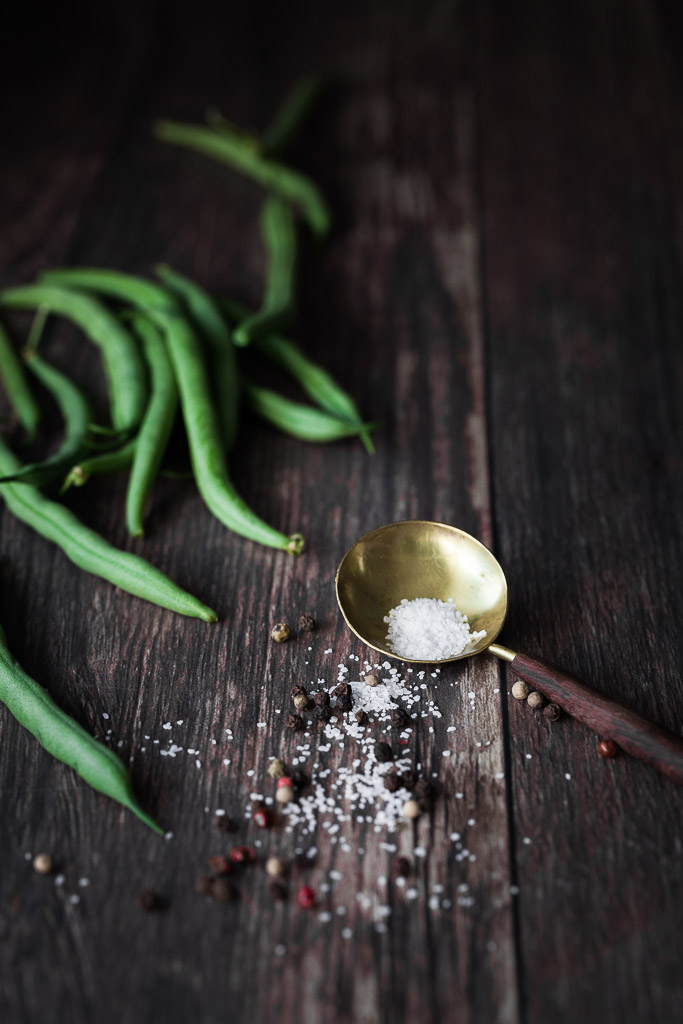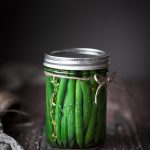Flavorful, snappy, pickled green beans at home in as little as 48 hours. These quick pickled green beans (refrigerator pickled beans) are the perfect addition to Caesars, sandwiches, salads or charcuterie boards. This recipe does not yield shelf stable pickles—quick pickled green beans must stay in the fridge. Makes 2 pints.

Jump to:

Quick Pickling vs Lacto-Fermenting
There are countless recipes for the perfect pickle- a quick google search will tell you that. However, did you know that there are only two main methods to for pickling? The two methods are are salt-water brining (lacto-fermenting) or immersion in vinegar solution (quick pickling). Both methods are great, but have some differences.
In short, salt-water brining (lacto-fermenting), involves beneficial bacteria converting a foods natural sugars and starches into lactic acid- this forms an acidic and probiotic-rich brine which prevents food spoilage. Vinegar pickling (quick or sometimes called refrigerator pickling), uses an already acidic solution (vinegar) to create an optimal preserving environment.
While the vinegar method lacks the beneficial bacteria and depth of flavour of fermentation, the process is faster and still produces a crunchy flavourful pickle. If lacto-fermentation seems intimidating, the vinegar or quick-pickling method might be your ticket to savouring that gorgeous sour sting of a good pickle.

Ingredients
You will need a few basic ingredients and special equipment for making this recipe.
Special equipment you will need:
- 2 wide-mouth 16 fluid ounce pint canning jars with lids and rings
- Paring knife and cutting board
- Small saucepan and spoon
Ingredients you will need:
- fresh green beans, washed
- pickling vinegar (7% acetic acid)
- filtered water
- pickling salt
- granulated sugar
- fresh dill or thyme
- black peppercorns
- mustard seeds

Instructions
This is a synopsis of the instructions for this recipe. For detailed instructions, please head to the recipe card.
STEP 1: Sterilize the equipment, and canning jars, then allow them to dry completely.
STEP 2: Divide the herbs and spices between each jar.
STEP 3: Wash and prepare the green beans by trimming off the stems so they fit into the clean jars.
STEP 4: Prepare an ice bath and and blanch the prepared green beans water.
STEP 5: Tightly pack the beans into the jars and prepare the brine.
STEP 6: Mix and heat the brine, then carefully pour or ladle it into the filled jars to within a ½ inch of the top, making sure the beans and fully immersed in the brine.


STEP 7: Seal the jars then allow the jars to cool at room temperature. Tighten the rings and place in the fridge to pickle for a minimum of 48 hours before consuming.

Important Tips
Choose the best green beans- great pickles start with great ingredients. You want to choose quality beans that are fresh, mature, firm, and blemish free with no signs of spoilage. Opt for green beans a little wider than a pencil. Discard any beans with any signs of spoilage, blemishes or imperfections.
Sterilize- all equipment and tools should be washed and sterilized thoroughly and then dried completely. This step helps to prevent any possible contamination. Also be sure to wash your hands thoroughly in advance.
Wash the produce - again this will help prevent possible contamination and help remove any unwanted pesticides or residues.
Prep the beans - Cut off the stems, but leaving the pointy ends. Trim the beans so they fit in the jars with a minimum ½ inch of space left at the top.
Blanch the beans- this helps retain their bright green colour and helps reduce foodborne pathogens.
Don't alter the brine ingredients - a high level of acidity is required to make sure the beans pickle correctly and to help prevent contamination. Most quick pickle recipes use a brine with a 1:1 ratio of water and vinegar.
Make sure the brine is heated and mixed properly - A uniform acidity is required to help ensure the beans pickle correctly to help prevent contamination.
Tightly pack and fully immerse in the brine - it's critical that the beans stay submerged in the brine in order to pickle properly. Tightly packing the beans will help prevent any from floating upwards; any pieces that are not submerged in brine may develop mold or bacterial growth and compromise the jar.
Leave headspace - ensuring there is a ½ inch of space left at the top of the jar will help make sure you have enough room to fully submerge the beans and prevent any brine from overflowing or getting around the lid and ring. Note: leaving headspace is also important for creating a safe vacuum seal during the heat processing/canning process; while this recipe isn't for heat processed pickles, allow for the headspace for the reasons noted above.

Storage
Quick pickled green beans need to stay refrigerated because there is no canning/heat processing involved with this recipe - this recipe is NOT shelf stable.
This recipe will keep for up to 2 weeks in the fridge. Some people keep them for longer, however, it is best to consume these within 1-2 weeks time. I also suggest making a note of the date you prepared them and keeping it on hand for reference.
If you note any cloudiness, mold, fizzy bubbles, slime, or otherwise weird things happening, discard the quick pickled beans right away. And, if you're ever in doubt, discard and don't take a chance.

Important Safety Notes
If you're new to the science of pickling and preservation, I recommend reading up on the topic (some resources below). As with any preservation method, it's important to familiarize yourself with best practices for avoiding contamination and knowing when a preserve may not be safe to eat.
All pickles carry some risk of food poisoning caused by bacteria, however, quick pickles are generally quite safe to eat. Always use your best judgment; if you note any cloudiness, mold, fizzy bubbles, slime, or otherwise indications of spoilage discard the quick pickled beans right away. And if you're ever in doubt, discard and don't take a chance.
Furthermore, you may want to be cautious when consuming pickles if you are pregnant, have a compromised or weakened immune system etc. Moreover, to be extra cautious, I prefer to keep these just for my husband and I, and not for our children.
Serving Suggestions
Some of the ways to enjoy quick pickled beans are:
- Caesar drinks
- Salads
- Charcuterie boards
- Burger or sandwich toppings instead of standard pickles
- As a side
- As a quick snack all on their own
Pickling Resources
Pickling has a long history and was an important means of preserving food before refrigerators and freezers became common place. These are a few pickling and preserving resources. I suggest reading up on the fascinating art and science of pickling and learning more about at home pickling safety.
National Center for Home Preservation
The Art of Fermentation- Sandor Ellix Katz
Ball Complete Book of Home Preserving - Judi Kingry
Preservation: The Art and Science of Canning, Fermentation and Dehydration-Christina Ward

FAQs
Quick pickling is a time saving method of preserving that essentially uses vinegar to brine and preserve food. There's no lengthy fermentation period or heat processing needed.
Quick pickles are also referred to as refrigerator pickles. As their name implies, they need to stay in the fridge and can't be stored on the pantry shelves unlike heat processed or canned pickles.
No. This recipe has not been tested for safety with canning as it was designed to be a refrigerator/quick pickle recipe. As such, if you want heat processed/canned pickled green beans, please follow a recipe specifically designed for that purpose.
More Recipes
If you love this recipe, you may also enjoy:
Roast Potato Salad with Sunflower Dijon Toss

Quick Pickled Green Beans (Refrigerator Pickled Beans)
Special Equipment
- 2-16 fl oz pint mason jars with fitted rings and lids
Ingredients
- 520 grams fresh green beans
- 1 ¼ cups pickling vinegar, 7% acetic acid
- 1 ¼ cups filtered water
- 1 tablespoon pickling salt
- 1 tablespoon granulated sugar
- 2 sprigs fresh dill or thyme, washed
- 2 teaspoon black peppercorns
- 1 teaspoon mustard seeds
Instructions
Prepare the Jars & Beans
- In hot soapy water, carefully wash two wide-mouth 16oz pint jars (including the lids and rings). Place the jars, lids and rings in a large pot and carefully pour boiling water over them to cover. Allow to sit for 5 minutes, then using tongs and heatproof gloves, carefully remove the jars, lids and rings from the water, discard any excess, and allow them to dry completely.
- Divide the herbs and spices between each sterilized jar. Set aside.
- Wash the green beans and trim off the stems so they fit into the jars with ½" headspace. Prepare an ice bath. Add trimmed beans to a medium pot of boiling water and cook for 1 ½ minutes. Carefully strain the hot beans, then submerge them into the ice bath for 1 minute. Remove and dry thoroughly.
- Tightly pack the blanched beans vertically into the jars leaving a ½” headspace at the top. The beans should be packed tight enough so they won’t float once brine is added.
Prepare the brine
- In a small pot, bring the vinegar, water, salt and sugar to a boil. Stir until the salt and sugar are fully dissolved.
- Remove from heat and carefully pour or ladle the hot brine into the filled jars to within a ½” of the top, making sure the beans are fully immersed in the brine. Gently tap the jars to remove any bubbles then top with more brine if necessary.
Seal and Refrigerate
- Place the lid on each jar and loosely screw on the rings. Allow the jars to cool at room temperature, then tighten the rings and place in the fridge to pickle for a minimum of 48 hours before consuming.
Notes
Nutrition
This is an approximation of the nutrition offered in this recipe, and is created using a nutrition calculator. I am not a nutritionist and cannot guarantee accuracy. If your health depends on nutrition information, please calculate again with your preferred calculator.
Disclaimer
all recipes on The Simple Green are developed and tested in a Canadian kitchen, at normal elevation, using electric appliances and ingredients available in Canada. Results may vary.

HI Elizabeth! I'm so happy to hear it! Unfortunately, I haven't water bathed this recipe before and this recipe hasn't been tested for that purpose. I would find an alternate recipe specifically for canning pickled green beans.
These are perfect in a ceasar and so easy to make. Love this recipe, thank you!
So glad you like it, Megan!
This looks so good, lovely photos and I look forward to trying your recipe!
So happy you like it, Perilla!
Looks great! Can I heat process this recipe for my pantry shelf?
Hi Kim! I haven't developed this recipe for heat processing, so I would advise against it. There are recipes available for heat processed pickled green beans.